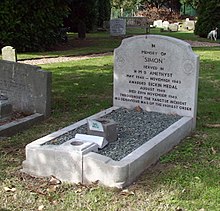Simon (cat)
Simon | |
|---|---|
 Simon in quarantine, November 1949 | |
| Born | 1947 |
| Died | 28 November 1949 (aged 2) |
| Cause of death | Viral infection, possibly caused by war wounds |
| Resting place | Plot 281 of the PDSA's pet cemetery in Ilford, Essex |
| Occupation(s) | Ship's cat of HMS Amethyst, honorary 'Able Seacat' |
| Employer | Royal Navy |
| Known for | Received several medals due to exemplary conduct in the Yangtze incident |
Simon (c. 1947 - 28 November 1949) was the ship's cat who served on the Royal Navy sloop HMS Amethyst. In 1949, during the Yangtze Incident, he received the PDSA's Dickin Medal after surviving injuries from a cannon shell, raising morale, and killing off a rat infestation during his service.[1]
Origin
Simon was found wandering the dockyards of Hong Kong in March 1948 by 17-year-old Ordinary Seaman George Hickinbottom, a member of the crew of the British frigate HMS Amethyst stationed in the city in the late 1940s. At this stage, it is thought Simon was approximately a year old, and was very undernourished and unwell. Hickinbottom smuggled the cat aboard ship, and Simon soon ingratiated himself with the crew and officers, particularly because he was adept at catching and killing rats on the lower decks. Simon rapidly gained a reputation for cheekiness, leaving presents of dead rats in sailors' beds, and sleeping in the captain's cap.[2]
The crew viewed Simon as a lucky mascot, and when the ship's commander changed later in 1948, the outgoing Ian Griffiths left the cat for his successor Lieutenant Commander Bernard Skinner, who took an immediate liking to the friendly animal. However, Skinner's first mission in command of the Amethyst was to travel up the Yangtze River to Nanking to replace the duty ship there, HMS Consort. Halfway up the river the ship became embroiled in the "Yangtze incident", when Chinese communist gun batteries opened fire on the frigate. One of the first rounds tore through the captain's cabin, seriously wounding Simon. Lt Cdr Skinner died of his wounds soon after the attack.
Recovery
The badly wounded cat crawled on deck, and was rushed to the medical bay, where the ship's surviving medical staff cleaned his burns, and removed four pieces of shrapnel, but he was not expected to last the night. He did manage to survive however, and after a period of recovery, he returned to his former duties in spite of the indifference he faced from the new ship's captain, Lt Cdr John Kerans. While anchored in the river, the ship had become overrun with rats, and Simon took on the task of removing them with vigour, as well as raising the morale of the sailors.[3]
Following the ship's escape from the Yangtze, Simon became an instant celebrity, lauded in British and world news, and presented with the "Animal Victoria Cross", the Dickin Medal, as well as a Blue Cross medal, the Amethyst campaign medal, and the fanciful rank of "Able Seacat". Thousands of letters were written to him, so much that one Lt Stuart Hett was appointed "cat officer" to deal with Simon's post. At every port Amethyst stopped at on its route home, Simon was presented with honour, and a special welcome was made for him at Plymouth in November when the ship returned. Simon was, however, like all animals entering the UK, subject to quarantine regulations, and was immediately sent to an animal centre in Surrey.
Death
Whilst in quarantine, Simon contracted a virus and, despite the attentions of medical staff and thousands of well-wishers, died on 28 November 1949 from a complication of the viral infection caused by his war wounds. Hundreds, including the entire crew of HMS Amethyst attended his funeral at the PDSA Ilford Animal Cemetery in East London.[4] His gravestone reads:
IN
MEMORY OF
"SIMON"
SERVED IN
H.M.S. AMETHYST
MAY 1948 — NOVEMBER 1949
AWARDED DICKIN MEDAL
AUGUST 1949
DIED 28TH NOVEMBER 1949.
THROUGHOUT THE YANGTZE INCIDENT
HIS BEHAVIOUR WAS OF THE HIGHEST ORDER
Simon is also commemorated with a bush planted in his honour in the Yangtze Incident Grove at the National Memorial Arboretum in Staffordshire.
In 1950, the writer Paul Gallico dedicated his novel Jennie to Simon.
References
External links
- The Friends of the Four Ships forum for veterans of HMS Amethyst, Consort, London and Black Swan
- Animal VC's
